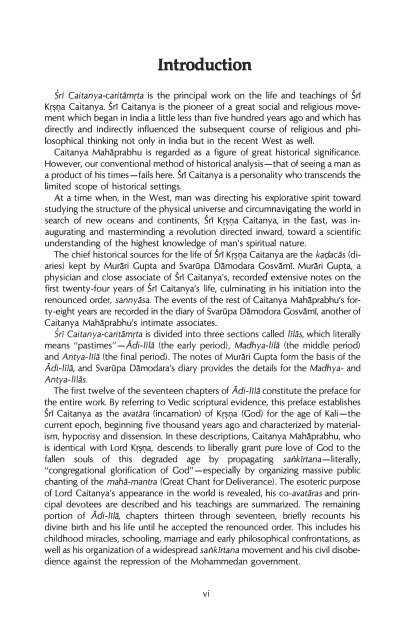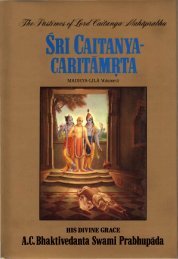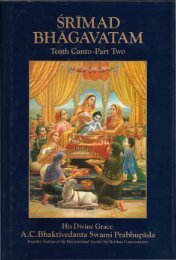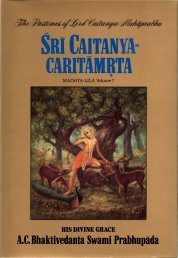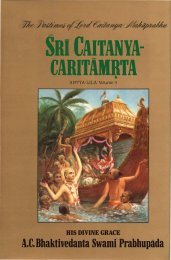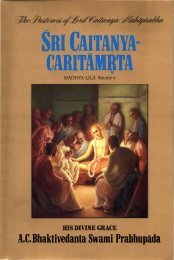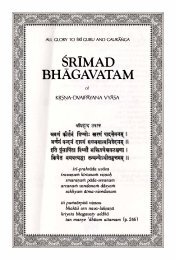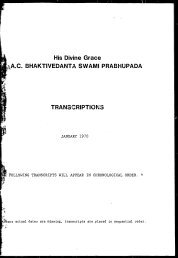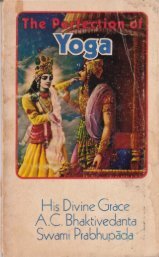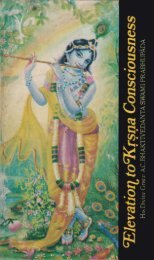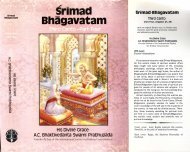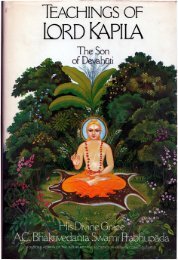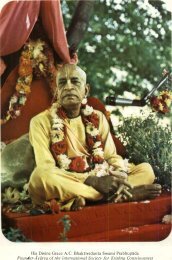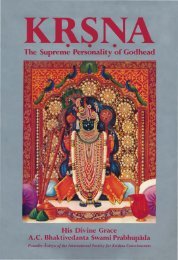- Page 1 and 2: - MADHYA-LILA Volume 3 HIS DIVINE G
- Page 3 and 4: - SRI CAITANYA- CARITAMRTA •
- Page 5 and 6: All Glory to Sri Guru and Gaurariga
- Page 7: Introduction Chapter 7 Chapter 8 Ch
- Page 11 and 12: His Divine Crace A C. Bhaktivedanta
- Page 13 and 14: ABOVE· · Th BELOW · A . Rl '" 15
- Page 15 and 16: LEFT: The Tirupati temple, a famous
- Page 17 and 18: Sri Ranga-k�etra, the largest tem
- Page 20: PLATE TWO "There was also one brahm
- Page 24: PLATE FOUR 'Then Gayatri, mother of
- Page 28: PLATE SIX "The pastimes of Sri Radh
- Page 32: PLATE EIGHT "The Buddhists could un
- Page 35 and 36: 2 Sri Caitanya-caritamrta [Madhya-l
- Page 37 and 38: 4 Sri Caitanya-caritamrta [Madhya-l
- Page 39 and 40: 6 Sri Caitanya-caritamrta [Madhya-l
- Page 41 and 42: 8 Sri Caitanya-caritamrta [Madhya-l
- Page 43 and 44: 10 Sri Caitanya-caritamrta [Madhya-
- Page 45 and 46: 12 Sri Caitanya-caritamrta [Madhya-
- Page 47 and 48: 14 Sri Caitanya-caritamrta [Madhya-
- Page 49 and 50: 16 Sri Caitanya-caritamrta [Madhya-
- Page 51 and 52: 18 Sri Caitanya-caritamrta [Madhya-
- Page 53 and 54: 20 Sri Caitanya-caritampa jala-patr
- Page 55 and 56: 22 Sri Caitanya-caritamrta [Madhya-
- Page 57 and 58: 24 Sri Caitanya-caritamrta [Madhya-
- Page 59 and 60:
26 Sri Caitanya-caritamrta [Madhya-
- Page 61 and 62:
28 Sri Caitanya-caritamrta [Madhya-
- Page 63 and 64:
30 Sri Caitanya-caritamrta [Madhya-
- Page 65 and 66:
32 Sri Caitanya-caritamrta [Madhya-
- Page 67 and 68:
34 Sri Caitanya-caritam!'fa [Madhya
- Page 69 and 70:
36 Sri Caitanya-caritamrta [Madhya-
- Page 71 and 72:
38 Sri Caitanya-caritamrta [Madhya-
- Page 73 and 74:
40 Sri Caitanya-caritamrta [Madhya-
- Page 75 and 76:
42 Sri Caitanya-caritamrta atikala
- Page 77 and 78:
44 Sri Caitanya-caritamrta [Madhya-
- Page 79 and 80:
46 Sri Caitanya-caritamrta [Madhya-
- Page 81 and 82:
48 Sri Caitanya-caritam!'fa [Madhya
- Page 83 and 84:
50 Sri Caitanya-caritamrta [Madhya-
- Page 85 and 86:
52 Sri Caitanya-caritampa [Madhya-l
- Page 87 and 88:
54 Sri Caitanya-caritamrta [Madhya-
- Page 89 and 90:
56 Sri Caitanya-caritamrta [Madhya-
- Page 91 and 92:
58 Sri Caitanya-caritamrta [Madhya-
- Page 93 and 94:
60 Sri Caitanya-caritamrta [Madhya-
- Page 95 and 96:
62 Sri Caitanya-caritamrta [Madhya-
- Page 97 and 98:
64 Sri Caitanya-caritamrta [Madhya-
- Page 99 and 100:
66 Sri Caitanya-caritam!'fa [Madhya
- Page 101 and 102:
68 Sri Caitanya-caritamrta [Madhya-
- Page 103 and 104:
70 Sri Caitanya-caritamrta [Madhya-
- Page 105 and 106:
72 Sri Caitanya-caritamrta [Madhya-
- Page 107 and 108:
74 Sri Caitanya-caritamrta [Madhya-
- Page 109 and 110:
76 Sri Caitanya-caritamrta TEXT 151
- Page 111 and 112:
78 Sri Caitanya-caritam!'fa [Madhya
- Page 113 and 114:
80 Sri Caitanya-caritamrta [Madhya-
- Page 115 and 116:
82 Sri Caitanya-caritam!'fa [Madhya
- Page 117 and 118:
84 Sri Caitanya-caritam!1a [Madhya-
- Page 119 and 120:
86 Sri Caitanya-caritamrta [Madhya-
- Page 121 and 122:
88 Sri Caitanya-caritamrta [Madhya-
- Page 123 and 124:
90 Sri Caitanya-caritamrta [Madhya-
- Page 125 and 126:
92 Sri Caitanya-caritamrta [Madhya-
- Page 127 and 128:
94 Sri Caitanya-caritamrta [Madhya-
- Page 129 and 130:
96 Sri Caitanya-caritamrfa [Madhya-
- Page 131 and 132:
98 Sri Caitanya-caritamrta marh hi
- Page 133 and 134:
100 Sri Caitanya-caritam!1a [Madhya
- Page 135 and 136:
102 Sri Caitanya-caritamrta mahad-v
- Page 137 and 138:
104 Sri Caitanya-caritamrta [Madhya
- Page 139 and 140:
106 Sri Caitanya-caritamrta [Madhya
- Page 141 and 142:
108 Sri Caitanya-caritampa [Madhya-
- Page 143 and 144:
110 Sri Caitanya-caritamrta [Madhya
- Page 145 and 146:
112 Sri Caitanya-caritamrta sva-kar
- Page 147 and 148:
114 Sri Caitanya-caritamrta [Madhya
- Page 149 and 150:
116 Sri Caitanya-caritamrta [Madhya
- Page 151 and 152:
118 Sri Caitanya-caritamrta [Madhya
- Page 153 and 154:
120 Sri Caitanya-caritamrta [Madhya
- Page 155 and 156:
122 Sri Caitanya-caritamrta [Madhya
- Page 157 and 158:
124 Sri Caitanya-caritlmrta kr?Qa-b
- Page 159 and 160:
126 Sri Caitanya-caritam�ta PURPO
- Page 161 and 162:
128 Sri Caitanya-caritam!'fa Deity;
- Page 163 and 164:
Text 80] Talks Between the Lord and
- Page 165 and 166:
132 Sri Caitanya-caritamrta [Madhya
- Page 167 and 168:
134 Sri Caitanya-caritamrta [Madhya
- Page 169 and 170:
136 Sri Caitanya-caritam�a [Madhy
- Page 171 and 172:
138 Sri Caitanya-caritam!'fa [Madhy
- Page 173 and 174:
140 Sri Caitanya-caritamrta [Madhya
- Page 175 and 176:
142 Sri Caitanya-caritamrta [Madhya
- Page 177 and 178:
144 Sri Caitanya-caritamrta [Madhya
- Page 179 and 180:
146 Sri Caitanya-caritamrta tatrati
- Page 181 and 182:
148 Sri Caitanya-caritam�a [Madhy
- Page 183 and 184:
150 Sri Caitanya-caritamrta [Madhya
- Page 185 and 186:
152 Sri Caitanya-caritamrta [Madhya
- Page 187 and 188:
154 Sri Caitanya-caritam!1a [Madhya
- Page 189 and 190:
156 Sri Caitanya-caritamrta [Madhya
- Page 191 and 192:
158 Sri Caitanya-caritamrta [Madhya
- Page 193 and 194:
160 Sri Caitanya-caritam!'fa [Madhy
- Page 195 and 196:
162 Sri Caitanya-caritamrta [Madhya
- Page 197 and 198:
164 Sri Caitanya-caritamrta yasya y
- Page 199 and 200:
166 Sri Caitanya-carita.mrta [Madhy
- Page 201 and 202:
168 Sri Caitanya-caritamrta [Madhya
- Page 203 and 204:
170 Sri Caitanya-caritamrta [Madhya
- Page 205 and 206:
172 Sri Caitanya-caritamrta [Madhya
- Page 207 and 208:
174 Sri Caitanya-caritamrta [Madhya
- Page 209 and 210:
176 Sri Caitanya-caritam!'fa [Madhy
- Page 211 and 212:
178 Sri Caitanya-caritamrta 8� II
- Page 213 and 214:
180 Sri Caitanya-caritam!'fa [Madhy
- Page 215 and 216:
182 Sri Caitanya-caritamrta TEXT 14
- Page 217 and 218:
184 Sri Caitanya-caritamrta [Madhya
- Page 219 and 220:
186 Sri Caitanya-caritamrta hlada-t
- Page 221 and 222:
188 Sri Caitanya-caritamrta [Madhya
- Page 223 and 224:
190 Sri Caitanya-caritamrta [Madhya
- Page 225 and 226:
192 Sri Caitanya-caritam!'fa [Madhy
- Page 227 and 228:
194 Sri Caitanya-caritamrta [Madhya
- Page 229 and 230:
196 Sri Caitanya-caritamrta [Madhya
- Page 231 and 232:
198 Sri Caitanya-caritamrta [Madhya
- Page 233 and 234:
200 Sri Caitanya-caritamrta [Madhya
- Page 235 and 236:
202 Sri Caitanya-caritam!'fa [Madhy
- Page 237 and 238:
204 Sri Caitanya-caritamrta [Madhya
- Page 239 and 240:
206 Sri Caitanya-caritamrta [Madhya
- Page 241 and 242:
208 Sri Caitanya-caritam!'fa [Madhy
- Page 243 and 244:
210 Sri Caitanya-caritampa [Madhya-
- Page 245 and 246:
212 Sri Caitanya-caritamrta [Madhya
- Page 247 and 248:
214 Sri Caitanya-caritamrta [Madhya
- Page 249 and 250:
216 Sri Caitanya-caritamrta [Madhya
- Page 251 and 252:
218 Sri Caitanya-caritamrta [Madhya
- Page 253 and 254:
220 Sri Caitanya-caritamrta TEXT 21
- Page 255 and 256:
222 Sri Caitanya-caritamrta [Madhya
- Page 257 and 258:
224 Sri Caitanya-caritamrta premaiv
- Page 259 and 260:
226 Sri Caitanya-caritamrta [Madhya
- Page 261 and 262:
228 Sri Caitanya-caritamrta [Madhya
- Page 263 and 264:
230 Sri Caitanya-caritamrta [Madhya
- Page 265 and 266:
232 Sri Caitanya-caritamrta siddha-
- Page 267 and 268:
234 Sri Caitanya-caritamrta [Madhya
- Page 269 and 270:
236 Sri Caitanya-caritamrta [Madhya
- Page 271 and 272:
238 Sri Caitanya-caritamrta [Madhya
- Page 273 and 274:
240 Sri Caitanya-caritamrta [Madhya
- Page 275 and 276:
242 Sri Caitanya-caritamrta [Madhya
- Page 277 and 278:
244 Sri Caitanya-caritamrta tat-tad
- Page 279 and 280:
246 Sri Caitanya-caritamrta [Madhya
- Page 281 and 282:
248 Sri Caitanya-caritamrta [Madhya
- Page 283 and 284:
250 Sri Caitanya-caritamrta [Madhya
- Page 285 and 286:
252 Sri Caitanya-caritamrfa [Madhya
- Page 287 and 288:
254 Sri Caitanya-caritamrta [Madhya
- Page 289 and 290:
256 Sri Caitanya-caritamrta [Madhya
- Page 291 and 292:
258 Sri Caitanya-caritamrta [Madhya
- Page 293 and 294:
260 Sri Caitanya-caritam!'fa pracod
- Page 295 and 296:
262 Sri Caitanya-caritamrta [Madhya
- Page 297 and 298:
264 Sri Caitanya-caritamrta TEXT 27
- Page 299 and 300:
266 Sri Caitanya-caritamrta [Madhya
- Page 301 and 302:
268 Sri Caitanya-caritam!'fa [Madhy
- Page 303 and 304:
270 Sri Caitanya-caritamrta [Madhya
- Page 305 and 306:
272 Sri Caitan ya-caritam�a [Madh
- Page 307 and 308:
274 Sri Caitanya-caritamrta [Madhya
- Page 309 and 310:
276 Sri Caitanya-caritamrta [Madhya
- Page 311 and 312:
278 Sri Caitanya-caritam�a [Madhy
- Page 313 and 314:
280 Sri Caitanya-caritamrta [Madhya
- Page 315 and 316:
282 Sri Caitanya-caritam!'fa [Madhy
- Page 317 and 318:
284 Sri Caitanya-caritamrta [Madhya
- Page 319 and 320:
286 Sri Caitanya-caritamrta [Madhya
- Page 321 and 322:
288 Sri Caitanya-caritamrta [Madhya
- Page 323 and 324:
290 Sri Caitanya-caritamrta [Madhya
- Page 325 and 326:
292 Sri Caitanya-caritamrta [Madhya
- Page 327 and 328:
294 Sri Caitanya-caritamrta [Madhya
- Page 329 and 330:
296 Sri Caitanya-caritamrta [Madhya
- Page 331 and 332:
298 Sri Caitanya-caritamrta [Madhya
- Page 333 and 334:
300 Sri Caitanya-caritamrta [Madhya
- Page 335 and 336:
302 Sri Caitanya-caritamrta TEXT 21
- Page 337 and 338:
304 Sri Caitanya-caritamrta [Madhya
- Page 339 and 340:
306 Sri Caitanya-caritamrta [Madhya
- Page 341 and 342:
308 Sri Caitanya-caritam!'ta [Madhy
- Page 343 and 344:
310 Sri Caitanya-caritamrta [Madhya
- Page 345 and 346:
312 Sri Caitanya-caritam!1a [Madhya
- Page 347 and 348:
314 Sri Caitanya-caritamrta [Madhya
- Page 349 and 350:
316 Sri Caitanya-caritamtta [Madhya
- Page 351 and 352:
318 Sri Caitanya-caritampa [Madhya-
- Page 353 and 354:
320 Sri Caitanya-caritamrta [Madhya
- Page 355 and 356:
322 Sri Caitanya-caritamrta [Madhya
- Page 357 and 358:
324 Sri Caitanya-caritamrta [Madhya
- Page 359 and 360:
326 Sri Caitanya-caritamrta [Madhya
- Page 361 and 362:
328 Sri Caitanya-caritamrta [Madhya
- Page 363 and 364:
330 Sri Caitanya-caritamrta [Madhya
- Page 365 and 366:
332 Sri Caitanya-caritam!'fa [Madhy
- Page 367 and 368:
334 Sri Caitanya-caritamrta amrtali
- Page 369 and 370:
336 Sri Caitanya-caritam!'fa [Madhy
- Page 371 and 372:
338 Sri Caitanya-caritamrta [Madhya
- Page 373 and 374:
340 Sri Caitanya-caritamrta [Madhya
- Page 375 and 376:
342 Sri Caitanya-caritamrta [Madhya
- Page 377 and 378:
344 Sri Caitanya-caritam!'la TEXT 9
- Page 379 and 380:
346 Sri Caitanya-caritamrta [Madhya
- Page 381 and 382:
348 Sri Caitanya-caritamrta [Madhya
- Page 383 and 384:
350 Sri Caitanya-caritamrta [Madhya
- Page 385 and 386:
352 Sri Caitanya-caritamrta [Madhya
- Page 387 and 388:
354 Sri Caitanya-caritam!'fa [Madhy
- Page 389 and 390:
356 Sri Caitanya-caritamrta [Madhya
- Page 391 and 392:
358 Sri Caitanya-caritamrta [Madhya
- Page 393 and 394:
360 Sri Caitanya-caritamrta [Madhya
- Page 395 and 396:
362 Sri Caitanya-caritamrta [Madhya
- Page 397 and 398:
364 Sri Caitanya-caritamrta [Madhya
- Page 399 and 400:
366 Sri Caitanya-caritamf{a [Madhya
- Page 401 and 402:
368 Sri Caitanya-caritamrta [Madhya
- Page 403 and 404:
370 Sri Caitanya-caritamrta £Madhy
- Page 405 and 406:
372 Sri Caitanya-caritamrta [Madhya
- Page 407 and 408:
374 Sri Caitanya-caritamrta [Madhya
- Page 409 and 410:
376 Sri Caitanya-caritamrta [Madhya
- Page 411 and 412:
378 Sri Caitanya-caritamrta [Madhya
- Page 413 and 414:
380 Sri Caitanya-caritamrta [Madhya
- Page 415 and 416:
382 Sri Caitanya-caritam!'fa [Madhy
- Page 417 and 418:
384 Sri Caitanya-caritamrta Katha U
- Page 419 and 420:
Glossary Acarya-a spiritual master
- Page 421 and 422:
Glossary Mahamaya-the superintenden
- Page 423 and 424:
Bengali Pronunciation Guide BENGALI
- Page 425 and 426:
Index of Bengali and Sanskrit Verse
- Page 427 and 428:
Index of Bengali and Sanskrit Verse
- Page 429 and 430:
Index of Bengali and Sanskrit Verse
- Page 431 and 432:
Index of Bengali and Sanskrit Verse
- Page 433 and 434:
Index of Bengali and Sanskrit Verse
- Page 435 and 436:
Index of Bengali and Sanskrit Verse
- Page 437 and 438:
sri-rariga-k$elre tabe karilil gama
- Page 439 and 440:
Index of Bengali and Sanskrit Verse
- Page 441 and 442:
General Index Numerals in bold type
- Page 443 and 444:
Bhakti-rasamrta-sindhu quoted by Ca
- Page 445 and 446:
CaQ
- Page 447 and 448:
Education Elements devotional servi
- Page 449 and 450:
Imam vivasvate yogaril verse quoted
- Page 451 and 452:
Kr�oa orders of given in Citii an
- Page 453 and 454:
Mayavadis consider opposite of mate
- Page 455 and 456:
Pastimes of Kr�r:Ja and Radha com
- Page 457 and 458:
Rariga-k�etra visited by Caitanya
- Page 459 and 460:
Sense gratification material educat
- Page 461 and 462:
Sva-jivanadhikaril prarthyaril vers
- Page 463 and 464:
Vi�aya cha{fiya kabe suddha ha'be
- Page 465 and 466:
(continued from front flap) Madhya-


